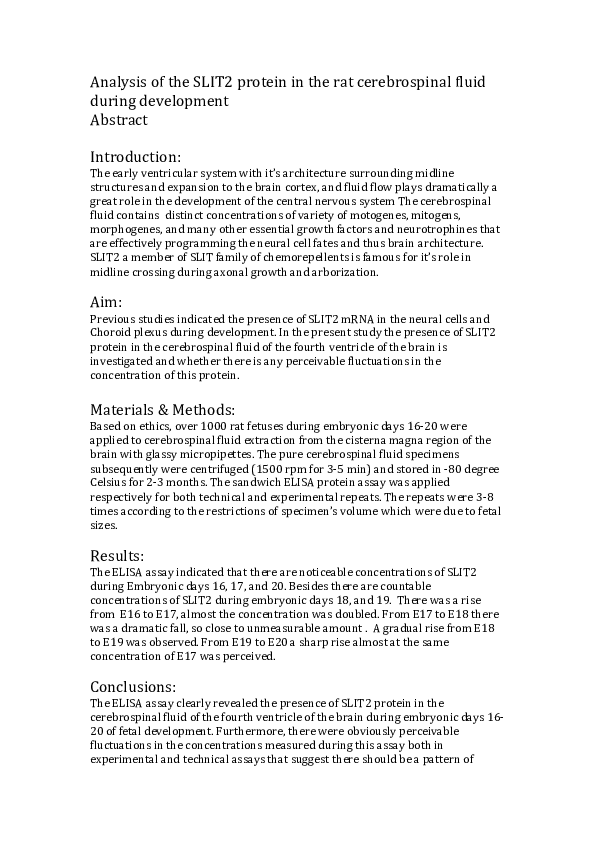Academia.edu no longer supports Internet Explorer.
To browse Academia.edu and the wider internet faster and more securely, please take a few seconds to upgrade your browser.
Analysis of the SLIT2 protein in the rat cerebrospinal fluid during development
Analysis of the SLIT2 protein in the rat cerebrospinal fluid during development
Introduction: The early ventricular system with it's architecture surrounding midline structures and expansion to the brain cortex, and fluid flow plays dramatically a great role in the development of the central nervous system The cerebrospinal fluid contains distinct concentrations of variety of motogenes, mitogens, morphogenes, and many other essential growth factors and neurotrophines that are effectively programming the neural cell fates and thus brain architecture. SLIT2 a member of SLIT family of chemorepellents is famous for it's role in midline crossing during axonal growth and arborization. Aim: Previous studies indicated the presence of SLIT2 mRNA in the neural cells and Choroid plexus during development. In the present study the presence of SLIT2 protein in the cerebrospinal fluid of the fourth ventricle of the brain is investigated and whether there is any perceivable fluctuations in the concentration of this protein. Materials & Methods: Based on ethics, over 1000 rat fetuses during embryonic days 16-‐20 were applied to cerebrospinal fluid extraction from the cisterna magna region of the brain with glassy micropipettes. The pure cerebrospinal fluid specimens subsequently were centrifuged (1500 rpm for 3-‐5 min) and stored in-‐80 degree Celsius for 2-‐3 months. The sandwich ELISA protein assay was applied respectively for both technical and experimental repeats. The repeats were 3-‐8 times according to the restrictions of specimen's volume which were due to fetal sizes. Results: The ELISA assay indicated that there are noticeable concentrations of SLIT2 during Embryonic days 16, 17, and 20. Besides there are countable concentrations of SLIT2 during embryonic days 18, and 19. There was a rise from E16 to E17, almost the concentration was doubled. From E17 to E18 there was a dramatic fall, so close to unmeasurable amount. A gradual rise from E18 to E19 was observed. From E19 to E20 a sharp rise almost at the same concentration of E17 was perceived. Conclusions: The ELISA assay clearly revealed the presence of SLIT2 protein in the cerebrospinal fluid of the fourth ventricle of the brain during embryonic days 16-‐ 20 of fetal development. Furthermore, there were obviously perceivable fluctuations in the concentrations measured during this assay both in experimental and technical assays that suggest there should be a pattern of
Related Papers
Developmental Biology
Proteins in cerebrospinal fluid and plasma of fetal rats during development1981 •
Annals of the New York Academy of Sciences
Intracellular Localization of Some Plasma Proteins in Human Embryonic and Fetal Brain with Special Reference to the Developing Cerebellum1983 •
Acta Pharmacologica Sinica
Over-expression of Slit2 induces vessel formation and changes blood vessel permeability in mouse brain2011 •
Molecular Brain Research
Cloning and expressions of three mammalian homologues of Drosophila slit suggest possible roles for Slit in the formation and maintenance of the nervous system1998 •
Developmental Brain Research
Comparison of proteins in CSF of lateral and IVth ventricles during early development of fetal sheep1983 •
Neuropathology and Applied Neurobiology
Developmental profile of plasma proteins in human fetal cerebrospinal fluid and blood1991 •
Croatian Medical Journal
The embryonic blood-cerebrospinal fluid barrier function before the formation of the fetal choroid plexus: role in cerebrospinal fluid formation and homeostasis2014 •
Developmental Brain Research
Immunohistochemical identification of some plasma proteins in human embryonic and fetal forebrain with particular reference to the development of the neocortex1984 •
The Open Proteomics Journal
Most of the Abundant Protein Fractions of Embryonic Cerebrospinal Fluid are Produced Out of the Brain Anlagen2008 •
RELATED PAPERS
2013 •
De Calltaÿ, G., Cavagna, M. et Van den Abeele, B. (éds), Speculum arabicum. Intersecting Perspectives on Medieval Encyclopaedism, Louvain-la-Neuve, 2021, p. 97-112.
« La géographie dans les encyclopédies mameloukes (XIIIe - XIVe s.) : entre vision figée du monde et mise à jour »The Institute of Art and Ideas
The Revolutionary Roots of Russia's War2024 •
DOAJ (DOAJ: Directory of Open Access Journals)
Next of kin’s protracted challenges with access to relevant information and involvement opportunities2018 •
Apunts Educacion Fisica Y Deportes
Aeróbic deportivo: importancia del conocimiento previo del error en el aprendizaje y retención de una habilidad gimnástica de salto2006 •
2020 •
JURNAL RISET KESEHATAN POLTEKKES DEPKES BANDUNG
Analisis Faktor-Faktor Kepatuhan Penerapan Standar Operasional Prosedur Pengambilan Darah Vena2019 •
Coronavirus Pandemia, Global Economic Crisis, Stress and Health.
Coronavirus Pandemia, Global Economic Crisis, Stress and Health.RELATED TOPICS
- Find new research papers in:
- Physics
- Chemistry
- Biology
- Health Sciences
- Ecology
- Earth Sciences
- Cognitive Science
- Mathematics
- Computer Science

 Afsaneh Zargarani
Afsaneh Zargarani